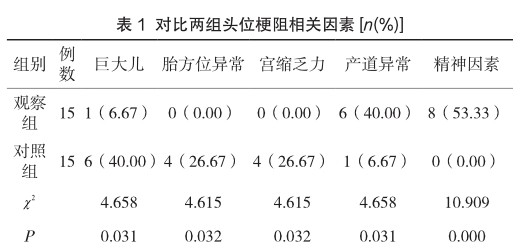探讨头位梗阻性难产产妇的临床特点与治疗措施


打开文本图片集
【摘 要】目的:分析产科产妇头位梗阻性难产的临床特点与治疗措施。方法:于2018年10月—2020年10月自产科选入30例头位梗阻性难产产妇,其中15例采取剖宫产分娩者为观察组、15例经阴道分娩者为对照组,比较分析两组治疗效果。结果:两组头位梗阻性相关因素发生率差异显著,观察组胎儿娩出第1min、5min、10min新生儿Apgar评分均高于对照组,母婴相关并发症发生率均低于对照组(P
【关键词】产科;头位梗阻性难产;临床特点;治疗措施
To explore the clinical features and treatment measures of dystocia due to head obstruction
HOU Xiaofeng
Renze District People’s Hospital, Xingtai City, Xingtai, Hebei 055150, China
【Abstract】Objective:To analyze the clinical characteristics and treatment of head obstructive dystocia in obstetric parturients.Methods:From October 2018 to October 2020, 30 cases of cephalic obstructive dystocia were enrolled from the obstetric department. Among them,15 cases were given by cesarean section as the observation group, and 15 cases were given by vagina as the control group.Comparison and analysis the treatment effect of the two groups. Results: The incidence of cephalic obstruction related factors between the two groups was significantly different.The Apgar scores of newborns in the observation group at 1min, 5min, and 10 min were higher than those in the control group, and the incidence of maternal and infant-related complications were lower than those in the control group(P
【Key?Words】Obstetrics;Head obstructive dystocia;Clinicalfeatures;Treatment measures
产妇分娩总是伴随着无数的风险,难产在当前产科中并不少见,头位梗阻性难产作为其中较为常见的一类,可能与胎儿体位不正、产道异常、巨大儿等多种因素有关[1]。(剩余3244字)